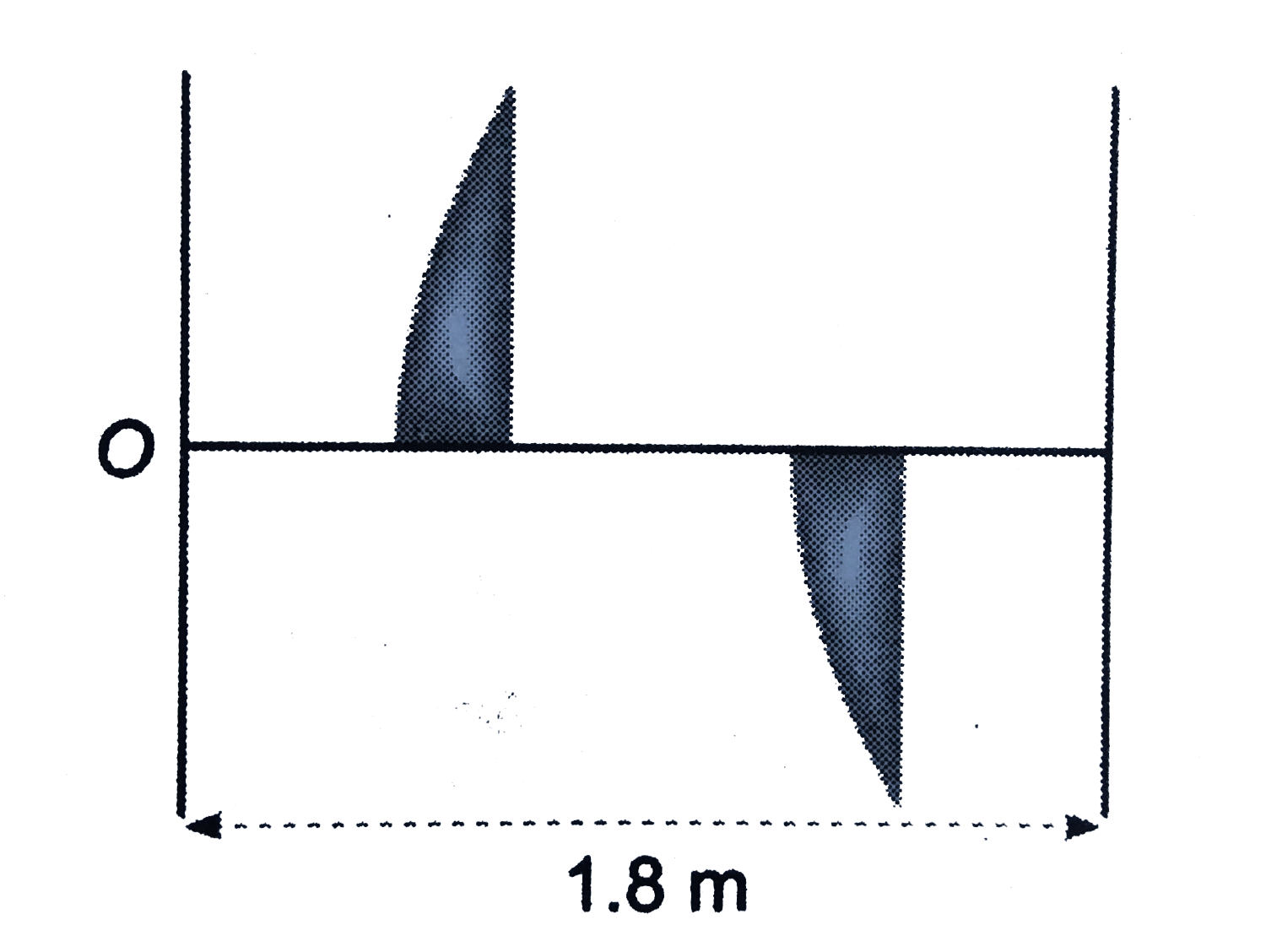ADDITIONAL PRACTICE EXERCISE (LEVEL-II LECTURE SHEET(ADVANCED) STRAIGHT OBJECTIVE TYPE QUESTIONS) from AAKASH SERIES Chapter 18 GEOMETRICAL OPTICS for Class 12
| Class 12 | PHYSICS |
| Chapter | GEOMETRICAL OPTICS |
| AAKASH SERIES | ADDITIONAL PRACTICE EXERCISE (LEVEL-II LECTURE SHEET(ADVANCED) STRAIGHT OBJECTIVE TYPE QUESTIONS) |
| Medium | English |
| Academic Year | 2023-2024 |
Question 3
A fish rising vertically to the surface of water in a lake uniformly at the rate of3m/s observes a king fisher bird diving vertically towards water at the rate 9 m/s vertically above it. If the refractive index of water is 4/3, find the actual velocity of the dive of the bird in cm/sec. View Solution
View SolutionQuestion 7
A person looking through a telescope focuses lens at a point on the edge of the bottom of an empty cylindrical vessel. Next he fills the entire vessel with a liquid oif refractive index μ, without disturbing the telescope. Now, he observes the mid point of the vessel. Determine the radius to depth ratio of the vesselView SolutionQuestion 8
A rod of glass (μ=1.5) and of square cross section is bent into the shape shown in the figure. A parallel beam of light falls on the plane flat surface A as shown in the figure. If d is the width of a side and R is the radius of circular are then for what maximum value of dR light entering the glass slab through surface A emerges from the glass through B
 View Solution
View SolutionQuestion 14
A ball is kept at a height h above the surface of a heavy transparent sphere made of a material of refractive index The radius of the sphere is R. At t = 0, the ball is dropped to fall normally on the sphere. Find the speed of the image formed as a function of time for t<√2hg. Consider only the image by a single refraction. View SolutionQuestion 20
A point object moves along the principal axis of a convex lens of focal length f such that its real image, also formed on the principal axis at a distance 4f3 (at t=0) moves away from the lens with uniform velocity α. Find the velocity of the point object as a function of time t.View SolutionQuestion 21
A thin plano-convex lens of focal length f is split into two halves. One of the halves is shifted along the optical axis as shown in figure. The sepration between object and image planes is 1.8m. The magnification of the image formed by one of the half lens is 2. Find the focal length of the lens and separation between the two halves. Draw the ray diagram for image formation.
 View Solution
View SolutionQuestion 27
A plano-convex lens has thickness 4cm. When places on a horizontal table with the curved surface in contact with it, the apparent depth of the bottom-most point of the lens if found to be 3cm. If the lens is inverted such that the plane face of the lens is in contact with the table, the apparent depth of the center of the plane face of the lens is found to be 25/8 cm. Find the focal length of the lens. View Solution
All Exercises from AAKASH SERIES Class 12 PHYSICS GEOMETRICAL OPTICS
- ADDITIONAL PRACTICE EXERCISE (LEVEL-I (MAIN) STRAIGHT OBJECTIVE TYPE QUESTIONS)
- ADDITIONAL PRACTICE EXERCISE (LEVEL-II LECTURE SHEET(ADVANCED) INTEGER TYPE QUESTIONS)
- ADDITIONAL PRACTICE EXERCISE (LEVEL-II LECTURE SHEET(ADVANCED) LINKED COMPREHENSION TYPE QUESTIONS)
- ADDITIONAL PRACTICE EXERCISE (LEVEL-II LECTURE SHEET(ADVANCED) MATRIX MATCHING TYPE QUESTIONS)
- ADDITIONAL PRACTICE EXERCISE (LEVEL-II LECTURE SHEET(ADVANCED) MORE THAN ONE CORRECT ANSWER TYPE QUESTIONS)
- ADDITIONAL PRACTICE EXERCISE (LEVEL-II LECTURE SHEET(ADVANCED) STRAIGHT OBJECTIVE TYPE QUESTIONS)
- ADDITIONAL PRACTICE EXERCISE (LEVEL-II PRACTICE SHEET (ADVANCED) INTEGER TYPE QUESTIONS)
- ADDITIONAL PRACTICE EXERCISE (LEVEL-II PRACTICE SHEET (ADVANCED) LINKED COMPREHENSION TYPE QUESTIONS)
- ADDITIONAL PRACTICE EXERCISE (LEVEL-II PRACTICE SHEET (ADVANCED) MATRIX MATCHING TYPE QUESTIONS)
- ADDITIONAL PRACTICE EXERCISE (LEVEL-II PRACTICE SHEET (ADVANCED) MORE THAN ONE CORRECT ANSWER TYPE QUESTIONS)
- ADDITIONAL PRACTICE EXERCISE (LEVEL-II PRACTICE SHEET (ADVANCED) STRAIGHT OBJECTIVE TYPE QUESTIONS)
- ADDITIONAL PRACTICE EXERCISE -I (LEVEL-I(MAIN) STRAIGHT OBJECTIVE TYPE QUESTIONS)
- ADDITIONAL PRACTICE EXERCISE -I (LEVEL-II LECTURE SHEET (ADVANCED) INTEGER TYPE QUESTIONS)
- ADDITIONAL PRACTICE EXERCISE -I (LEVEL-II LECTURE SHEET (ADVANCED) LINKED COMPREHENSION TYPE QUESTIONS)
- ADDITIONAL PRACTICE EXERCISE -I (LEVEL-II LECTURE SHEET (ADVANCED) MATRIX MATCHING TYPE QUESTIONS)
- ADDITIONAL PRACTICE EXERCISE -I (LEVEL-II LECTURE SHEET (ADVANCED) MORE THAN ONE CORRECT TYPE QUESTIONS)
- ADDITIONAL PRACTICE EXERCISE -I (LEVEL-II LECTURE SHEET (ADVANCED) STRAIGHT OBJECTIVE TYPE QUESTIONS)
- LECTURE SHEET (EXERCISE I LEVEL -I (MAIN) STRAIGHT OBJECTIVE TYPE QUESTIONS)
- LECTURE SHEET (EXERCISE I LEVEL -II (ADVANCED) INTEGER TYPE QUESTIONS)
- LECTURE SHEET (EXERCISE I LEVEL -II (ADVANCED) LINKED COMPREHENSION ANSWER TYPE QUESTIONS)
- LECTURE SHEET (EXERCISE I LEVEL -II (ADVANCED) MATRIX MATCHING ANSWER TYPE QUESTIONS)
- LECTURE SHEET (EXERCISE I LEVEL -II (ADVANCED) MORETHAN CORRECT ANSWER TYPE QUESTIONS)
- LECTURE SHEET (EXERCISE I LEVEL -II (ADVANCED) STRAIGHT OBJECTIVE TYPE QUESTIONS)
- LECTURE SHEET (EXERCISE II LEVEL -I (MAIN) STRAIGHT OBJECTIVE TYPE QUESTIONS)
- LECTURE SHEET (EXERCISE II LEVEL -II (ADVANCED) INTEGER TYPE QUESTIONS)
- LECTURE SHEET (EXERCISE II LEVEL -II (ADVANCED) LINKED COMPREHENSION TYPE QUESTIONS)
- LECTURE SHEET (EXERCISE II LEVEL -II (ADVANCED) MATRIX MATCHING TYPE QUESTIONS)
- LECTURE SHEET (EXERCISE II LEVEL -II (ADVANCED) MORE THAN ONE CORRECT TYPE QUESTIONS)
- LECTURE SHEET (EXERCISE II LEVEL -II (ADVANCED) STRAIGHT OBJECTIVE TYPE QUESTIONS)
- LECTURE SHEET (EXERCISE III LEVEL -I (MAIN) STRAIGHT OBJECTIVE TYPE QUESTIONS)
- LECTURE SHEET (EXERCISE III LEVEL -II (ADVAMCED) INTEGER TYPE QUESTIONS)
- LECTURE SHEET (EXERCISE III LEVEL -II (ADVAMCED) LINKED COMPREHENSION TYPE QUESTIONS)
- LECTURE SHEET (EXERCISE III LEVEL -II (ADVAMCED) MATRIX MATCHING TYPE QUESTIONS)
- LECTURE SHEET (EXERCISE III LEVEL -II (ADVAMCED) MORE THAN ONE CORRECT TYPE QUESTIONS)
- LECTURE SHEET (EXERCISE III LEVEL -II (ADVAMCED) STRAIGHT OBJECTIVE TYPE QUESTIONS)
- LECTURE SHEET (EXERCISE-I (LEVEL-I (MAIN) STRAIGHT OBJECTIVE TYPE QUESTIONS))
- LECTURE SHEET (EXERCISE-I (LEVEL-II (ADVANCED) INTEGER TYPE QUESTIONS))
- LECTURE SHEET (EXERCISE-I (LEVEL-II (ADVANCED) LINKED COMPREHENSION TYPE QUESTIONS))
- LECTURE SHEET (EXERCISE-I (LEVEL-II (ADVANCED) MATRIX MATCHING TYPE QUESTIONS))
- LECTURE SHEET (EXERCISE-I (LEVEL-II (ADVANCED) MORE THAN ONE CORRECT ANSWER TYPE QUESTIONS))
- LECTURE SHEET (EXERCISE-I (LEVEL-II (ADVANCED) STRAIGHT OBJECTIVE TYPE QUESTIONS))
- LECTURE SHEET (EXERCISE-II (LEVEL-I (MAIN) STRAIGHT OBJECTIVE TYPE QUESTIONS))
- LECTURE SHEET (EXERCISE-II (LEVEL-II (ADVANCED) INTEGER TYPE QUESTIONS))
- LECTURE SHEET (EXERCISE-II (LEVEL-II (ADVANCED) LINKED COMPREHENSION TYPE QUESTIONS))
- LECTURE SHEET (EXERCISE-II (LEVEL-II (ADVANCED) MATRIX MATCHING TYPE QUESTIONS))
- LECTURE SHEET (EXERCISE-II (LEVEL-II (ADVANCED) STRAIGHT OBJECTIVE TYPE QUESTIONS))
- LECTURE SHEET (EXERCISE-III (LEVEL-I (MAIN) STRAIGHT OBJECTIVE TYPE QUESTIONS))
- LECTURE SHEET (EXERCISE-III (LEVEL-II (ADVANCED) INTEGER TYPE QUESTIONS))
- LECTURE SHEET (EXERCISE-III (LEVEL-II (ADVANCED) LINKED COMPREHENSION TYPE QUESTIONS))
- LECTURE SHEET (EXERCISE-III (LEVEL-II (ADVANCED) MATRIX MATCHING TYPE QUESTIONS))
- LECTURE SHEET (EXERCISE-III (LEVEL-II (ADVANCED) MORE THAN ONE CORRECT ANSWER TYPE QUESTIONS))
- LECTURE SHEET (EXERCISE-III (LEVEL-II (ADVANCED) STRAIGHT OBJECTIVE TYPE QUESTIONS))
- PRACTICE SHEET (ADVANCED) (INTEGER TYPE QUESTIOS)
- PRACTICE SHEET (ADVANCED) (LINKED COMPREHENSION CORRECT TYPE QUESTIOS)
- PRACTICE SHEET (ADVANCED) (MATRIX MATCHING TYPE QUESTIOS)
- PRACTICE SHEET (ADVANCED) (MORE THAN ONE CORRECT TYPE QUESTIOS)
- PRACTICE SHEET (ADVANCED) (STRAIGHT OBJECTIVE TYPE QUESTIOS)
- PRACTICE SHEET (EXERCISE I LEVEL -I (MAIN) STRAIGHT OBJECTIVE TYPE QUESTIONS)
- PRACTICE SHEET (EXERCISE I LEVEL -II (ADVANCED) INTEGER TYPE QUESTIONS)
- PRACTICE SHEET (EXERCISE I LEVEL -II (ADVANCED) LINKED COMPREHENSION TYPE QUESTIONS)
- PRACTICE SHEET (EXERCISE I LEVEL -II (ADVANCED) MATRIX MATCHING TYPE QUESTIONS)
- PRACTICE SHEET (EXERCISE I LEVEL -II (ADVANCED) MORE THAN ONE CORRECT TYPE QUESTIONS)
- PRACTICE SHEET (EXERCISE I LEVEL -II (ADVANCED) STRAIGHT OBJECTIVE TYPE QUESTIONS)
- PRACTICE SHEET (EXERCISE II LEVEL -I (MAIN) STRAIGHT OBJECTIVE TYPE QUESTIONS)
- PRACTICE SHEET (EXERCISE II LEVEL -II (ADVANCED) INTEGER TYPE QUESTIONS)
- PRACTICE SHEET (EXERCISE II LEVEL -II (ADVANCED) LINKED COMPREHENSION TYPE QUESTIONS)
- PRACTICE SHEET (EXERCISE II LEVEL -II (ADVANCED) MATRIX MATCHING TYPE QUESTIONS)
- PRACTICE SHEET (EXERCISE II LEVEL -II (ADVANCED) STRAIGHT OBJECTIVE TYPE QUESTIONS)
- PRACTICE SHEET (EXERCISE III LEVEL -I (MAIN) STRAIGHT OBJECTIVE TYPE QUESTIONS)
- PRACTICE SHEET (EXERCISE III LEVEL -II (ADVANCED) INTEGER TYPE QUESTIONS)
- PRACTICE SHEET (EXERCISE III LEVEL -II (ADVANCED) LINKED COMPREHENSION TYPE QUESTIONS)
- PRACTICE SHEET (EXERCISE III LEVEL -II (ADVANCED) MORE THAN ONE CORRECT TYPE QUESTIONS)
- PRACTICE SHEET (EXERCISE III LEVEL -II (ADVANCED) STRAIGHT OBJECTIVE TYPE QUESTIONS)
- PRACTICE SHEET (EXERICSE-I (LEVEL-I (MAIN) STRAIGHT OBJECTIVE TYPE QUESTIONS))
- PRACTICE SHEET (EXERICSE-I (LEVEL-II (ADVANCED) INTEGER TYPE QUESTIONS))
- PRACTICE SHEET (EXERICSE-I (LEVEL-II (ADVANCED) LINKED COMPREHENSION TYPE QUESTIONS))
- PRACTICE SHEET (EXERICSE-I (LEVEL-II (ADVANCED) MATRIX MATCHING TYPE QUESTIONS))
- PRACTICE SHEET (EXERICSE-I (LEVEL-II (ADVANCED) MORE THAN ONE CORRECT ANSWER TYPE QUESTIONS))
- PRACTICE SHEET (EXERICSE-I (LEVEL-II (ADVANCED) STRAIGHT OBJECTIVE TYPE QUESTIONS))
- PRACTICE SHEET (EXERICSE-II (LEVEL-I (MAIN) STRAIGHT OBJECTIVE TYPE QUESTIONS))
- PRACTICE SHEET (EXERICSE-II (LEVEL-II (ADVANCED) INTEGER TYPE QUESTIONS))
- PRACTICE SHEET (EXERICSE-II (LEVEL-II (ADVANCED) LINKED COMPREHENSION TYPE QUESTIONS))
- PRACTICE SHEET (EXERICSE-II (LEVEL-II (ADVANCED) MATRIX MATCHING TYPE QUESTIONS))
- PRACTICE SHEET (EXERICSE-II (LEVEL-II (ADVANCED) STRAIGHT OBJECTIVE TYPE QUESTIONS))
- PRACTICE SHEET (EXERICSE-III (LEVEL-I (MAIN) )
- PRACTICE SHEET (EXERICSE-III (LEVEL-II (ADVANCED) INTEGER TYPE QUESTIONS ))
- PRACTICE SHEET (EXERICSE-III (LEVEL-II (ADVANCED) LINKED COMPREHENSION TYPE QUESTIONS ))
- PRACTICE SHEET (EXERICSE-III (LEVEL-II (ADVANCED) MORE THAN ONE CORRECT ANSWER TYPE QUESTIONS ))
- PRACTICE SHEET (EXERICSE-III (LEVEL-II (ADVANCED) STRAIGHT OBJECTIVE TYPE QUESTIONS ))






